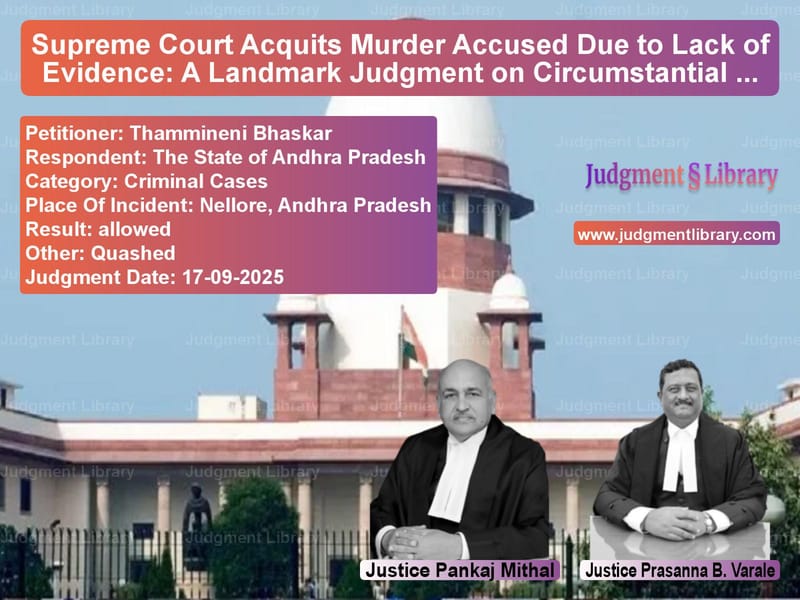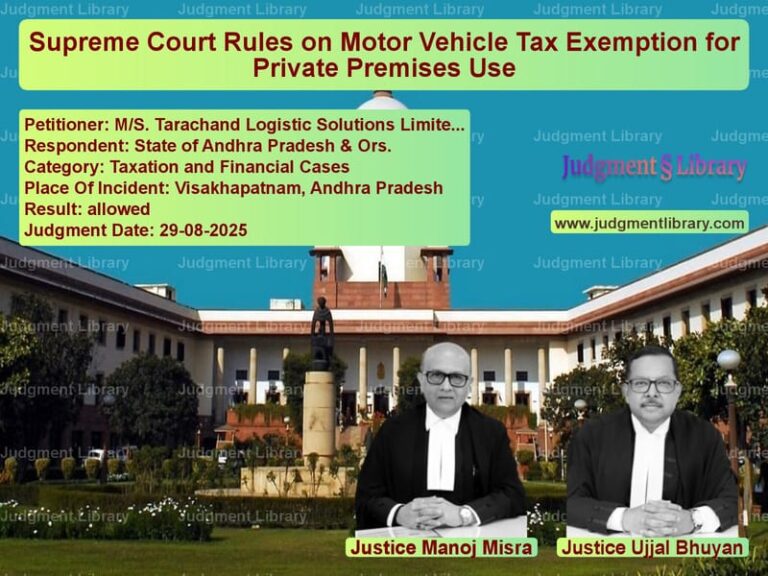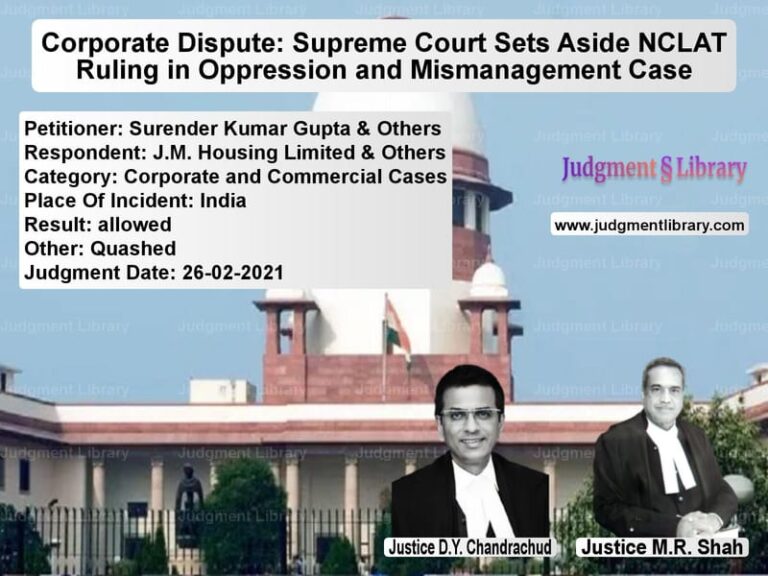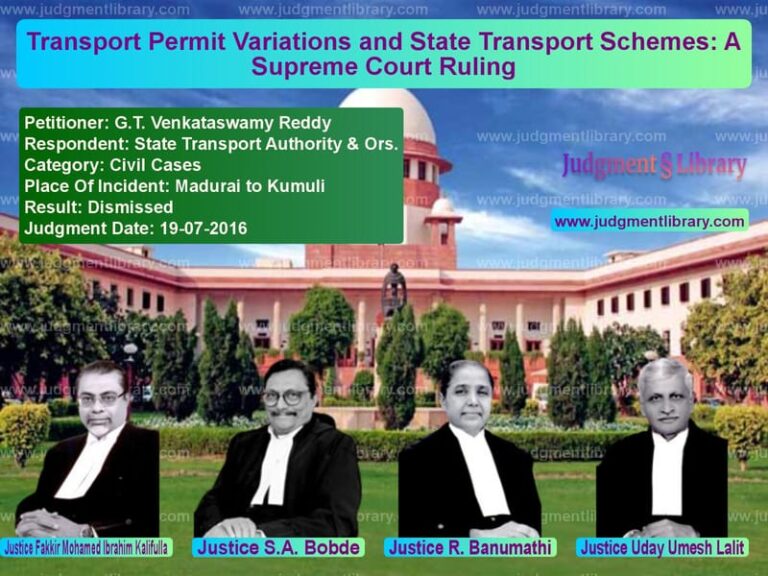Supreme Court Acquits Murder Accused Due to Lack of Evidence: A Landmark Judgment on Circumstantial Evidence
In a significant judgment delivered on September 17, 2025, the Supreme Court of India acquitted Thammineni Bhaskar, who had been convicted and sentenced to life imprisonment for the alleged murder of Bhoominadhan. The case, which had traveled through the trial court and the High Court, finally found resolution in the nation’s highest court, highlighting crucial principles of criminal jurisprudence, particularly concerning circumstantial evidence and the burden of proof.
The case dates back to March 26, 2016, when Bhoominadhan, an auto-rickshaw driver from Nellore, Andhra Pradesh, was allegedly kidnapped and later found dead near Sarvepalli Reservior of Anikepalli Village. The prosecution’s case rested on the theory that Bhaskar, along with his friends, had forcibly taken the deceased from his auto-rickshaw near a banyan tree in Talpagiri Colony. The father of the deceased, Rajagopal Vellimalai, had filed an FIR alleging that his son was abducted by Bhaskar and his associates.
The prosecution presented several witnesses, but two key witnesses—PW-5 and PW-6—played a pivotal role in the case. Initially, during the investigation, these witnesses had given statements under Section 161 of the Criminal Procedure Code (Cr.P.C.) and later under Section 164 Cr.P.C. before a magistrate, claiming they had seen the accused dragging the deceased into an auto-rickshaw. However, during the trial, their testimonies took a dramatic turn. Both witnesses turned hostile and failed to support the prosecution’s version of events.
During the appeal, the arguments presented by the appellant’s counsel, Mr. K.K. Mani, were critical. He contended that “there is no eye-witness in the case who might have seen A-1 committing the offence of killing the deceased. The conviction is entirely based on circumstantial evidence and more particularly on the testimony of PW-5 and PW-6. The aforesaid two witnesses PW-5 and PW-6 have turned hostile and they have not proved the kidnapping of the deceased Bhoominadhan. There is no evidence that the deceased was last seen with A-1 and therefore, he is not the person answerable and responsible for Bhoominadhan’s death.”
On the other hand, the respondent-State, represented by Ms. Prerna Singh, argued that “there was a clear motive on the part of the accused to commit the offence and that even if PW-5 and PW-6 have turned hostile, it has been proved by circumstantial evidence that A-1 and his friends are guilty of committing the offence as they failed to give any explanation as to what happened to the deceased after he was taken away by them in the evening of 26.03.2016.”
The Supreme Court, after a thorough examination of the evidence, found the prosecution’s case lacking in crucial aspects. The bench, comprising Justice Pankaj Mithal and Justice Prasanna B. Varale, noted that the testimony of PW-5 and PW-6, which formed the backbone of the prosecution’s case, had crumbled during the trial. The court observed: “We have gone through the statements of PW-5 and PW-6 and are of the clear view that they have not uttered a single word so as to prove the kidnapping as alleged or even that the deceased was with them at any point of time in the evening of 26.03.2016. The only thing proved from the statements of the aforesaid witnesses is that there was some ‘galata’ under the banyan tree in Talpagiri Colony but they were unable to identify the persons involved in it. They even failed to testify that any information was given by them to PW-1 regarding the alleged kidnapping of the deceased Bhoominadhan.”
The court further emphasized the importance of the “last seen” theory in criminal cases and noted that there was no substantial evidence to prove that the deceased was last seen in the company of the accused. The judgment stated: “In the absence of such evidence and the fact that both PW-5 and PW-6 have turned hostile, it cannot be held that A-1 was involved in the incident and that he was responsible for the killing of the deceased, on the basis of the last seen theory. There is no evidence to either prove the kidnapping of the deceased Bhoominadhan or that he was last seen in the company of A-1.”
One of the most significant aspects of this judgment is the court’s reiteration of the “five golden principles” or the “panchsheel” of proving a case based on circumstantial evidence. While the court did not elaborate on these principles in this particular judgment, they are well-established in Indian jurisprudence and include: (1) the circumstances from which the conclusion of guilt is to be drawn should be fully established; (2) the facts so established should be consistent only with the hypothesis of the guilt of the accused; (3) the circumstances should be of a conclusive nature and tendency; (4) they should exclude every possible hypothesis except the one to be proved; and (5) there must be a chain of evidence so complete as not to leave any reasonable ground for the conclusion consistent with the innocence of the accused.
The court concluded that the prosecution had failed to meet these standards, stating: “In view of the aforesaid facts and circumstances, and keeping in mind the five golden principles which constitute the panchsheel of the proof of a case based on circumstantial evidence, we are of the opinion that the prosecution has miserably failed to prove the commission of the offence at the hands of A-1.”
The Supreme Court also addressed the issue of motive, which the prosecution had emphasized. The court acknowledged that there was animosity between the parties due to a previous case where the mother of the deceased had filed a complaint against Bhaskar. However, the court rightly pointed out that “the aforesaid animosity between them may be the motive behind the crime but it is not sufficient to prove the commission of the crime unless the evidence proves kidnapping/abduction and killing of the deceased, either by direct or circumstantial evidence.”
This observation underscores a fundamental principle of criminal law: while motive can provide context, it cannot substitute for concrete evidence of the commission of the crime. The prosecution must prove the actus reus (the guilty act) beyond reasonable doubt, and motive alone cannot establish guilt.
The judgment serves as a reminder of the importance of reliable witness testimony in criminal cases. When key witnesses turn hostile, the entire foundation of the prosecution’s case can collapse, especially in cases reliant on circumstantial evidence. The court’s careful scrutiny of the witness statements and its refusal to convict based on unreliable testimony demonstrate the judiciary’s commitment to ensuring that convictions are based on solid evidence rather than conjecture.
In its final ruling, the Supreme Court declared: “Accordingly, both the Trial Court and the High Court erred in convicting the appellant-A-1 on complete misreading of the evidence. Thus, the impugned judgments and orders of the High Court and the Trial Court are hereby set aside and the accused A-1, the appellant herein, is acquitted of all the charges and is directed to be released forthwith, if not involved in any other case.”
This judgment reinforces the fundamental legal principle that in criminal cases, the burden of proof lies entirely on the prosecution, and the accused is presumed innocent until proven guilty. The standard of proof in criminal cases—”beyond reasonable doubt”—is intentionally high to prevent the miscarriage of justice. When the evidence presented fails to meet this standard, as in this case, acquittal becomes not just a legal necessity but a moral imperative.
The Supreme Court’s decision in Thammineni Bhaskar vs. State of Andhra Pradesh serves as an important precedent for future cases involving circumstantial evidence and hostile witnesses. It emphasizes that courts must meticulously examine the evidence and ensure that convictions are based on reliable and credible proof rather than assumptions or incomplete evidence. The judgment protects the rights of the accused while upholding the integrity of the criminal justice system.
Petitioner Name: Thammineni Bhaskar.Respondent Name: The State of Andhra Pradesh.Judgment By: Justice Pankaj Mithal, Justice Prasanna B. Varale.Place Of Incident: Nellore, Andhra Pradesh.Judgment Date: 17-09-2025.Result: allowed.
Don’t miss out on the full details! Download the complete judgment in PDF format below and gain valuable insights instantly!
Download Judgment: thammineni-bhaskar-vs-the-state-of-andhra-supreme-court-of-india-judgment-dated-17-09-2025.pdf
Directly Download Judgment: Directly download this Judgment
See all petitions in Murder Cases
See all petitions in Bail and Anticipatory Bail
See all petitions in Attempt to Murder Cases
See all petitions in Custodial Deaths and Police Misconduct
See all petitions in Other Cases
See all petitions in Judgment by Pankaj Mithal
See all petitions in Judgment by Prasanna Bhalachandra Varale
See all petitions in allowed
See all petitions in Quashed
See all petitions in supreme court of India judgments September 2025
See all petitions in 2025 judgments
See all posts in Criminal Cases Category
See all allowed petitions in Criminal Cases Category
See all Dismissed petitions in Criminal Cases Category
See all partially allowed petitions in Criminal Cases Category







